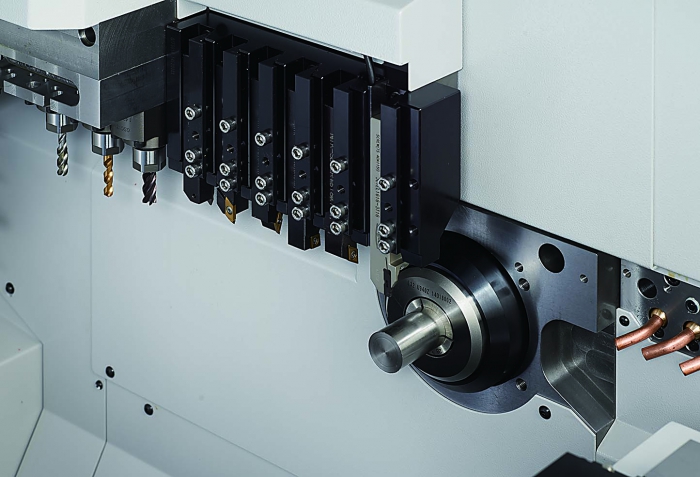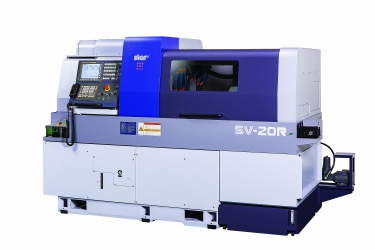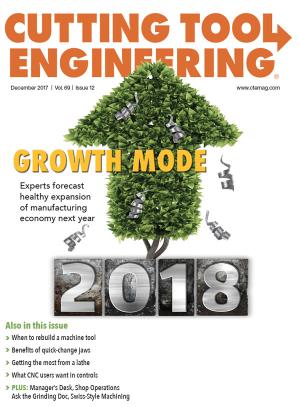When convertible spindles for Swiss-style CNC lathes were introduced a decade or so ago, many in the industry said they were only a fad. Yet those naysayers have been proven abundantly wrong, as headstocks that can be converted from sliding to fixed are becoming the norm on Swiss machines.
“In the near future, all of our machines will be convertible,” said Brian Such, customer support group manager at Marubeni Citizen-Cincom Inc., Allendale, N.J. “Right now, our M series is the only one that’s not.”
Such said convertible headstocks offer many benefits. Lower part cost is one. Because any out-of-roundness in bar stock held in a guide bushing is translated to the workpiece, bars must be centerless-ground to a roundness tolerance greater than that of the finished part.

With the guide bushing removed on a convertible Swiss-style machine, the remnant material is reduced and parts can be turned “more round” without the need for ground bar stock. Image courtesy of Marubeni Citizen-Cincom.
The up charge for ground bar stock may account for only a small percentage of the raw material cost, but it can quickly add up for automotive and consumer product manufacturers, where job quantities number in the hundreds of thousands.
The other complaint frequently heard among sliding-headstock users is about the cost of the bar remnant. Throwing away the 6" (152.4mm) or so of leftover material between the guide bushing and collet is no big deal with relatively inexpensive, 12'-long (3.7m) bars of steel or even stainless steel, but for medical machine shops turning ultraexpensive, yard-long bars of PEEK (polyetheretherketone) or platinum, it’s a profit killer.
A fixed headstock reduces the remnant length to about 1½" (38.1mm). Also, there’s no need to grind the bar stock. Parts will be as round as the lathe’s spindle bearings and accurate to whatever the machine is capable of (usually in the range of tenths).
The only caveat about convertible spindles concerns limited part length. Because the guide bushing is eliminated while in fixed-headstock mode, there’s no possibility of turning the long, slender workpieces to which Swiss users are accustomed. “A good rule of thumb is a length-to-diameter ratio of 3:1, the same as any other conventional lathe,” Such said.
Somewhat surprisingly, that’s OK with Swiss-style machine buyers. Ed Garber, regional manager for Star CNC Machine Tool Corp., Roslyn Heights, N.Y., said he carries a box of sample parts to show potential customers and at least 40 percent of the parts fall into the less than 3:1 length-to-diameter category.

The option to switch between collet and guide bushing is standard on most Swiss-style turning machines, such as this one from Star CNC Machine Tool. Image courtesy of Star CNC Machine Tool.
The majority of Star’s machines are also convertibles. “The extreme length-to-diameter demand isn’t what it used to be,” Garber said. “Most customers are more concerned with getting parts done in as few operations as possible.”
Of course, most customers are also concerned about setup time. The good news is that switching from a sliding headstock to a fixed one takes 15 to 60 minutes. Users remove some screws and the guide bushing unit, flip a switch or change a parameter setting, and the machine is as ready to make parts as its now-converted alter ego.
In addition, Garber pointed out that Swiss machines are substantially faster than turret-based CNC lathes. This makes convertible machines competitive with turn-mill machines and multitaskers, especially on very small parts.
“Swiss machines can go from chip to chip very quickly,” he said. “For example, within 3 seconds, we’re able to fully synchronize our subspindle and ready to cut off a part. You can’t do that on a conventional fixed-headstock lathe.”
Another thing you can’t do on a conventional lathe is run the spindle up to 8,000 rpm or higher, even when running bar stock 1½" in diameter. The ability to run higher spindle speeds has long been an advantage of Swiss-style lathes, and it hasn’t changed with the move to convertibles.
Perhaps the only downside to convertible Swiss machines is the learning curve. Processing parts will be somewhat different for those shops steeped in Swiss methodology.
“A shop that’s used to conventional turning is going to have an easier time with this, but it’s not all that difficult either way,” Such said. “It’s a great option for shorter parts, where accuracy is critical or where raw material costs are high.”
Related Glossary Terms
- bushing
bushing
Cylindrical sleeve, typically made from high-grade tool steel, inserted into a jig fixture to guide cutting tools. There are three main types: renewable, used in liners that in turn are installed in the jig; press-fit, installed directly in the jig for short production runs; and liner (or master), installed permanently in a jig to receive renewable bushing.
- collet
collet
Flexible-sided device that secures a tool or workpiece. Similar in function to a chuck, but can accommodate only a narrow size range. Typically provides greater gripping force and precision than a chuck. See chuck.
- computer numerical control ( CNC)
computer numerical control ( CNC)
Microprocessor-based controller dedicated to a machine tool that permits the creation or modification of parts. Programmed numerical control activates the machine’s servos and spindle drives and controls the various machining operations. See DNC, direct numerical control; NC, numerical control.
- lathe
lathe
Turning machine capable of sawing, milling, grinding, gear-cutting, drilling, reaming, boring, threading, facing, chamfering, grooving, knurling, spinning, parting, necking, taper-cutting, and cam- and eccentric-cutting, as well as step- and straight-turning. Comes in a variety of forms, ranging from manual to semiautomatic to fully automatic, with major types being engine lathes, turning and contouring lathes, turret lathes and numerical-control lathes. The engine lathe consists of a headstock and spindle, tailstock, bed, carriage (complete with apron) and cross slides. Features include gear- (speed) and feed-selector levers, toolpost, compound rest, lead screw and reversing lead screw, threading dial and rapid-traverse lever. Special lathe types include through-the-spindle, camshaft and crankshaft, brake drum and rotor, spinning and gun-barrel machines. Toolroom and bench lathes are used for precision work; the former for tool-and-die work and similar tasks, the latter for small workpieces (instruments, watches), normally without a power feed. Models are typically designated according to their “swing,” or the largest-diameter workpiece that can be rotated; bed length, or the distance between centers; and horsepower generated. See turning machine.
- tolerance
tolerance
Minimum and maximum amount a workpiece dimension is allowed to vary from a set standard and still be acceptable.
- turning
turning
Workpiece is held in a chuck, mounted on a face plate or secured between centers and rotated while a cutting tool, normally a single-point tool, is fed into it along its periphery or across its end or face. Takes the form of straight turning (cutting along the periphery of the workpiece); taper turning (creating a taper); step turning (turning different-size diameters on the same work); chamfering (beveling an edge or shoulder); facing (cutting on an end); turning threads (usually external but can be internal); roughing (high-volume metal removal); and finishing (final light cuts). Performed on lathes, turning centers, chucking machines, automatic screw machines and similar machines.


